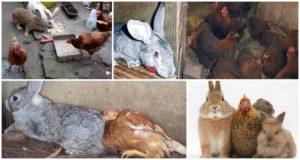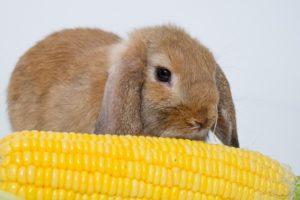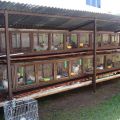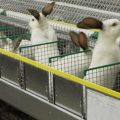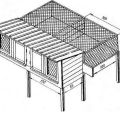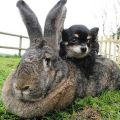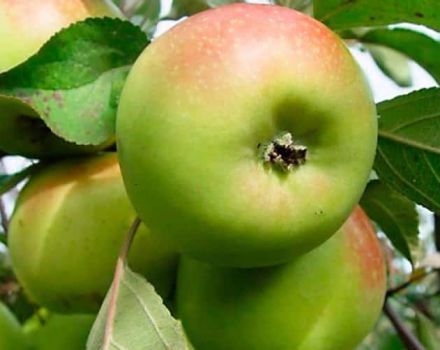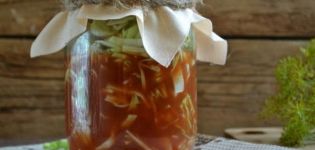Description and characteristics of the rizen breed rabbits, their colors and content
The Risen rabbit is characterized by large body dimensions and developed muscle mass. Animals provide not only high-quality dietary meat, but also fur of several expensive colors. The breed is popular and eagerly bred by farmers for sale, but also cute, non-aggressive and friendly rabbits make wonderful pets.
The history of the breed
The first representatives of the breed appeared in the County of Flanders (now part of the Belgian territory) in the 16th century. The rabbits had short, thick, dark gray fur, a muscular body, and strong legs. The ancestors of the breed weighed about 6 kg, their original name was the Belgian giants.
In the 19th century, representatives of the breed were brought to Germany, where they began to actively breed, carry out selection work to improve the breed characteristics. Improved rabbits (fleshy, gaining weight faster) were introduced in the middle of the 20th century as German giants.
Today rizen rabbits are raised for meat and fur in many European countries. But the existence of the German variety as a separate breed is still in question. Some experts believe that the rizen is not a breed, but only an offshoot of the Belgian giants.
Description and characteristics of rizen rabbits
External characteristics according to the breed standard German Riesen:
- the body is elongated by 75 cm;
- the head is large with fleshy cheeks;
- the ears are erect, up to 20 cm long, the ears are thick;
- eyes of a typical shape for rabbits, the iris is brown;
- the chest is voluminous, the girth of the chest is 40 cm;
- the hind legs are strong, large, with well-developed muscles;
- the front legs are strong, set wide apart to support the weight of a heavy animal;
- the coat is thick, short, hairs in length do not exceed 4 cm.
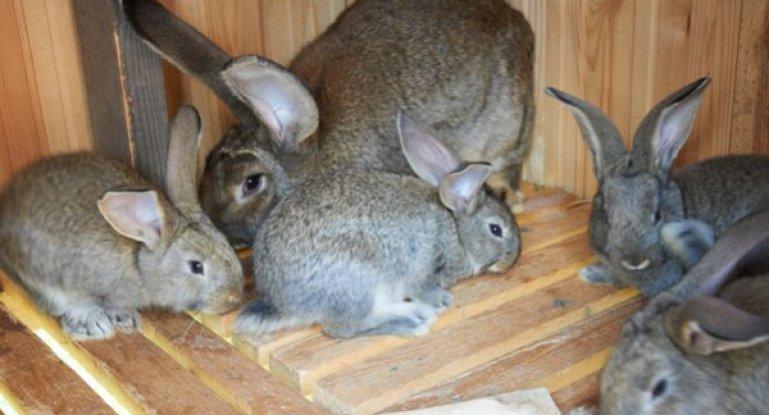
Riesen rabbits are included in the category of skin and meat breeds. An adult rabbit weighs 10 kg, but some individuals weigh 12-14 kg. The meat is high quality, juicy and tender. The color of the representatives of the Risen breed was originally agouti, that is, typical for wild rodents - zone gray and red. Furriers do not like this color of wool, although the skin of these rabbits is strong and of high quality. Therefore, for a long time, rizen rabbits were not bred for fur. Today, thanks to selective work, rabbits of different colors exist.
Blue and black individuals are common. There are also white, silver, sand, red rabbits.
Some breeders name rizen gold in their pet announcements.This name should not mislead buyers: it does not mean that animals differ from other representatives of the breed in higher productivity or other features. This is just an indication of the red color.
The rizen rabbit is distinguished by a calm, friendly, docile character, so he is kept not only for profit, but also as a pet. The behavioral feature of rizen rabbits is the absence of fearfulness. Therefore, representatives of the breed get along with other non-aggressive animals.

Main advantages and disadvantages
Pros of the German breed:
- complaisance and friendliness;
- attractive appearance;
- high quality meat for dietary consumption;
- valuable fur;
- high litter;
- the presence of a maternal instinct in rabbits.
Risen rabbits have disadvantages:
- long-term growth;
- slowness, sluggishness;
- significant feeding costs;
- susceptibility to obesity;
- the need for ample space for resettlement;
- tendency to disease, weak immune system;
- capriciousness in leaving.

Subtleties of keeping and caring for the breed
For rizen rabbits, it is necessary to create the best conditions for keeping. Animals cannot be ignored. The cages should be spacious so the animals can move freely. The optimal size of the dwelling per individual is 100 × 70 cm and a height of 50 cm.
Risen rabbits are also kept in the aviary. But it must be located on the southern or southeastern side of the site, it must have a ventilation system. The floor of the aviary or cage is lined with hay or sawdust. Moreover, the replacement of bedding material should be regular.
The cells are regularly cleaned, while the floor, ceiling, walls are disinfected with cleaning agents. During cleaning, the litter is completely changed, accumulated food residues and feces are removed. Also, do not forget about regular washing of feeders and drinkers. If you do not follow these recommendations, then rabbits will pick up a deadly infection.
Since Rizen pets are large, it is uncomfortable for them to constantly sit in a cage. Therefore, the rabbits are allowed out for a walk every few days. Rodents walk on a safe, fenced lawn, where there is no debris, no poisonous plants grow.
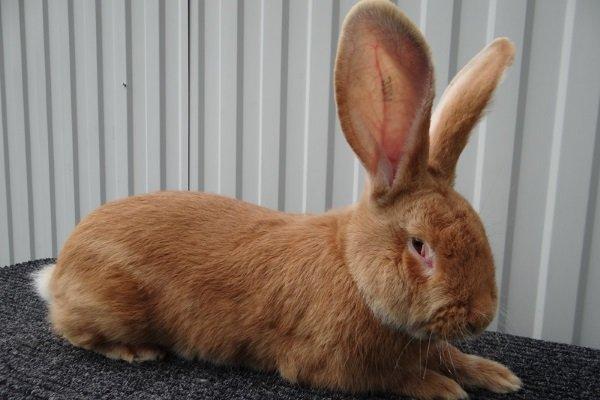
Feeding rabbits
Risen is fed to rabbits 2 times a day. The spring-summer diet should be balanced and vitamin-rich. Pets are fed with fresh grass, roots, twigs. In the winter months, the menu is simplified, based on hay and compound feed. The diet should periodically include vitamin and mineral supplements to strengthen the body and maintain immunity. You can buy drugs at pet stores and veterinary clinics. Rodents drink a lot, so clean water must be available at all times. Change it once a day.
Breeding rules
Breeding rizen rabbits is not an easy task. There is a high probability of genetic problems in the offspring if mating rules are not followed. Although rabbits reach sexual maturity by 3-4 months, the first mating is carried out after the animals reach 8 months of age. For mating, they choose the best individuals, strong and active.
Male and female are left alone for half an hour. It is advisable to remove the feeder so that the food does not distract the animals. After mating, you need to wait half a month, then palpate the female's abdomen to find out if she is pregnant. If fertilization has occurred, then the rabbit is moved to a separate cage. During pregnancy, the female is carefully looked after.
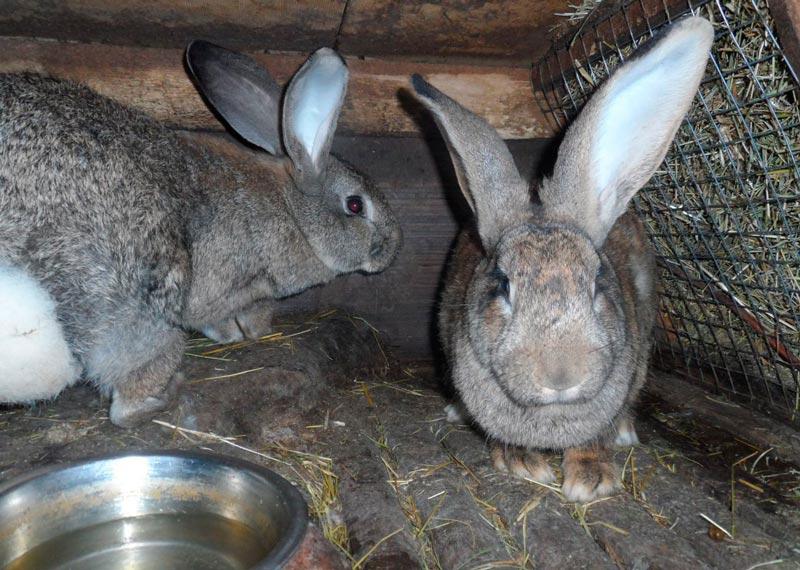
Preparing for childbirth, the rabbit begins to build a nest. Then the owner puts a convenient box in the cage, where the droppings will be. There is no need to help the rabbit in childbirth. Riesen rabbits give birth to 8-12 cubs. The maternal instinct is developed in the Risen breed.Bunnies protect the little rabbits, take care of them. During the lactation period, the female is abundantly fed, treated with steamed potatoes to stimulate the formation of milk.
Diseases and vaccinations
Rabbits of the rizen variety are prone to get sick, because their immunity cannot be called strong. Therefore, animal care must be meticulous. When buying animals, you need to pay attention to the obvious signs of pathologies:
- obesity or emaciated appearance;
- disproportionate physique;
- watery, swollen eyes;
- fur with bald patches and tangles;
- bumps and knots on the body;
- dirty ears;
- inappropriate, aggressive or fearful behavior.

Representatives of the Risen breed are sick:
- diabetes;
- obesity;
- visual pathologies;
- dermatological diseases;
- rickets;
- myxomatosis;
- viral hemorrhagic disease;
- coccidiosis;
- stomatitis caused by infection;
- tympania;
- spirochetes;
- psoroptosis;
- nematodes.
Rabbits are vaccinated against myxomatosis and hemorrhagic disease. The procedure is carried out by the farmer himself. Or call a veterinarian. If the animals live in an open-air cage or pit, then they are additionally vaccinated against rabies.
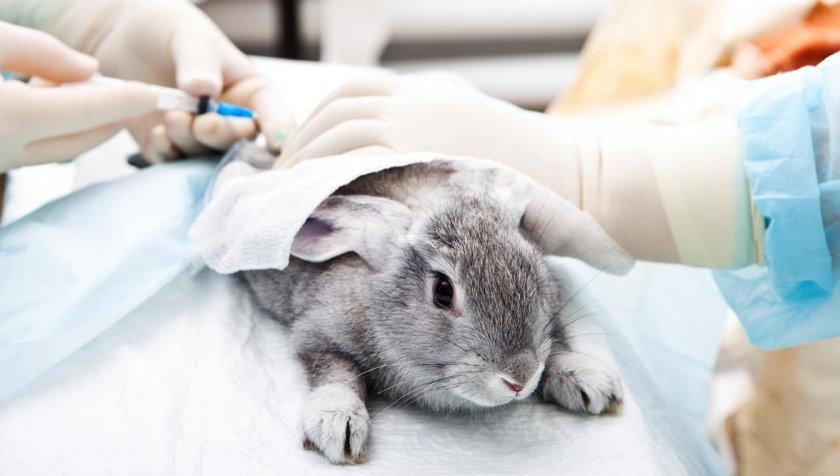
Vaccination begins when the rabbits reach the age of 1.5 months. Vaccines are given complex or separate. The complex preparation includes antibodies of both infections. From myxomatosis, the vaccine is given in the spring, since insects spread the infection. And for hemorrhagic disease they give a vaccine at any time of the year.
Individuals who have undergone anthelmintic treatment at least 10 days ago are allowed to be vaccinated. Before injection, animals are examined, the temperature is checked. If it is above 39.5 ° C, then the vaccination is canceled, since the rabbit is sick.
Where to buy and how much does it cost
Young individuals for fattening are bought in large breeding farms. And pure-bred males and females for reproduction - in nurseries of reputable breeders. The breeder provides the buyer with pedigrees of the pets sold, as well as documents with information on the age, weight and vaccinations of the animals.
The cost of young rizenes for fattening is 400-500 rubles per unit of live weight. For a breeding individual, you will have to pay at least 2,500 rubles. It is better to buy rizen rabbits that have reached 4-5 months of age. At this age, the animals have already been vaccinated, are less fearful, and are not exposed to stress.
